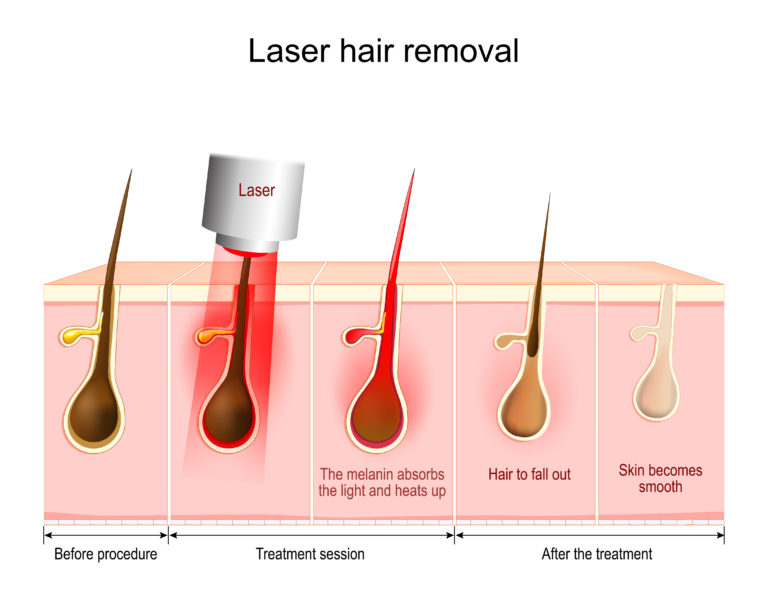
At EpilSoft, our center is equipped with Alexandrite and Nd-YAG lasers from the Candela brand, known for their effectiveness in permanent laser hair removal.
But why did we make this specific choice?
Indeed, there are various types of lasers and techniques on the market for permanent laser hair removal. Let’s take a look at these alternatives to better understand them.
HOW DO DIFFERENT TYPES OF LASERS WORK?
Before delving into the specifics of different options, it’s important to understand their basic functioning.
Lasers target the pigmentation of the hair, also known as melanin. They emit a highly concentrated beam of light with a precise wavelength. When this light is absorbed by melanin, it transforms into heat. When the pigment of the hair follicle (the cavity where the hair originates) is reached, the hair and its bulb are destroyed, preventing their regrowth.

The Alexandrite Laser
At EpilSoft, we have chosen to equip all our centers with Candela Alexandrite and Candela Nd-YAG lasers.
The Candela Alexandrite laser is widely recognized as one of the most effective and safe technologies for permanent hair removal for light to olive skin tones. It emits a precise and powerful beam of light that is specifically absorbed by the melanin present in the hair follicles. This allows for selective destruction of follicles without damaging the surrounding skin.
The Alexandrite laser is a type of laser commonly used in permanent hair removal. It gets its name from the precious stone “alexandrite,” which shares similar characteristics with this laser, particularly its ability to emit a specific wavelength. The Alexandrite laser emits light at a wavelength of 755 nanometers, making it ideal for selectively targeting the melanin in hair. Melanin efficiently absorbs this wavelength, allowing the laser to reach hair follicles located beneath the skin. The advantage of the Alexandrite laser is its ability to treat large areas of the body quickly and effectively. It can be used on various body parts, including the legs, underarms, bikini area, back, and face.
The ND-YAG Laser
The Nd-YAG laser emits a beam of light at a wavelength of 1064 nanometers, giving it the ability to penetrate deeper into the skin compared to other types of lasers. This makes it suitable for treating darker skin tones as it reduces the risk of thermal damage to the skin.
When the light emitted by the Nd:YAG laser is absorbed by the melanin in the hair, it converts into heat. This heat is then transferred to the hair follicles, resulting in the destruction of the cells responsible for hair growth.
The Nd-YAG laser is also used to treat vascular lesions such as spider veins and dilated blood vessels. It can also be used for skin rejuvenation and treating pigmented spots.
One of the advantages of the Nd:YAG laser is its ability to treat various skin types, including darker skin that might be more sensitive to other types of lasers.
The diode laser
The diode laser, although less effective than the Alexandrite laser, has the advantage of being more affordable and compact. This also makes it more easily portable. Its wavelength typically ranges between 810 and 980 nanometers, which corresponds to a broader wavelength spectrum than that of the Alexandrite and ND-Yag lasers.
The wavelength of the diode laser is less absorbed by melanin but allows for deeper penetration of the light beam. This presents both advantages and disadvantages. On one hand, tanning and skin pigmentation are less affected, which is an advantage. On the other hand, lighter and finer hairs may resist treatment more due to reduced light absorption.
While the diode laser technique shows promise, it is not yet considered mature. A significant number of sessions are often required to achieve satisfactory results. It’s important to note that the effectiveness of the treatment can vary from person to person based on skin color, hair pigmentation, and other individual factors.
Pulsed light
Intense Pulsed Light (IPL): IPL is not strictly a laser, but a technology that uses a wide range of wavelengths. The intense light pulses emitted by IPL are absorbed by the melanin in the hair, which results in the conversion of light into heat. This heat damages the cells of the hair follicles, thereby inhibiting their regrowth.
The flash lamps used for IPL hair removal emit less specific, less powerful, and more random light than lasers. Furthermore, the power of pulsed light is lower, leading to only temporary weakening of the hair follicle, providing transient rather than permanent results.
As a result, the outcomes of pulsed light are often less effective and disappointing, and they may carry higher risks of burns.
Intense Pulsed Light (IPL) vs Laser
LASER
Unlike IPL, the use of lasers is exclusively reserved for qualified personnel who have undergone specific training. The required training for laser practice makes this procedure highly regulated, subject to numerous efficacy and safety studies. Indeed, lasers are the only technique that can guarantee you permanent, safe, and effective removal of unwanted hair.



